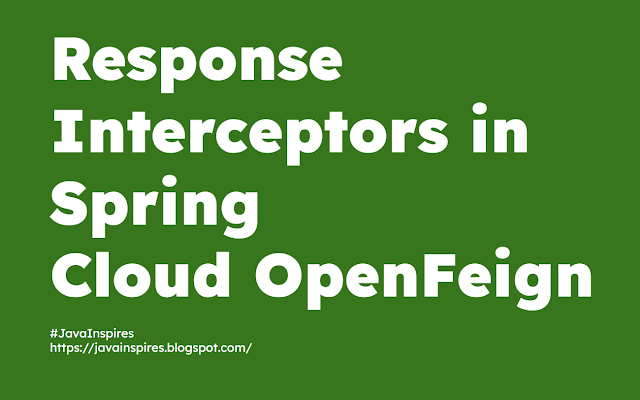Enhancing API Communication with Response Interceptors in Spring Cloud OpenFeign
Introduction:
In the realm of microservices architecture, seamless communication between services is paramount. Spring Cloud OpenFeign simplifies this process by providing a declarative way to interact with RESTful APIs. However, sometimes we need more than just making requests; we need insights into responses as well. Enter Response Interceptors - a powerful feature in Spring Cloud OpenFeign that allows us to intercept and manipulate responses before they reach their destinations. In this blog post, we'll explore how to leverage Response Interceptors to enhance API communication in your Spring Boot applications.
Understanding Response Interceptors:
Response Interceptors act as intermediaries between your application and the external APIs it interacts with. They intercept responses from these APIs, giving you the opportunity to inspect, modify, or log them before they're processed further. This capability is invaluable for scenarios such as error handling, logging, or even modifying responses to suit specific requirements.
advertisement
Implementing Response Interceptors in Spring Cloud OpenFeign:
Let's dive into implementing a Response Interceptor using Spring Cloud OpenFeign. Below is a step-by-step guide:
Step 1: Create a Configuration Class:
Start by creating a configuration class in your Spring Boot application. This class will define our Response Interceptor bean.
import feign.Response;import feign.ResponseInterceptor;import org.springframework.context.annotation.Bean;import org.springframework.context.annotation.Configuration;import org.springframework.http.HttpStatus;import java.io.IOException;@Configurationpublic class FeignInterceptorConfig {@Beanpublic ResponseInterceptor feignResponseInterceptor() {return new FeignResponseInterceptor();}private static class FeignResponseInterceptor implements ResponseInterceptor {@Overridepublic void apply(Response response) throws IOException {if (response.status() == HttpStatus.OK.value()) {// Successful response, you can modify or log it here// For example, you can log the response bodyString responseBody = Util.toString(response.body().asReader());System.out.println("Response Body: " + responseBody);} else {// Handle other HTTP status codes if needed}}}}
Step 2: Implement the Response Interceptor:
Inside the configuration class, implement the Response Interceptor logic within a nested class. In our example, we're logging the response body for successful requests.
Step 3: Apply the Configuration:
Ensure that your Spring Boot application picks up this configuration. Spring will automatically apply the Response Interceptor to your Feign clients.
advertisement
Conclusion:
Response Interceptors in Spring Cloud OpenFeign offer a powerful mechanism to enhance API communication in your Spring Boot applications. By intercepting and manipulating responses, you gain greater control over how your application interacts with external services. Whether it's logging, error handling, or customizing responses, Response Interceptors empower you to build more robust and resilient microservices architectures.
Start leveraging Response Interceptors today to elevate your API communication to the next level with Spring Cloud OpenFeign.
Happy coding!
